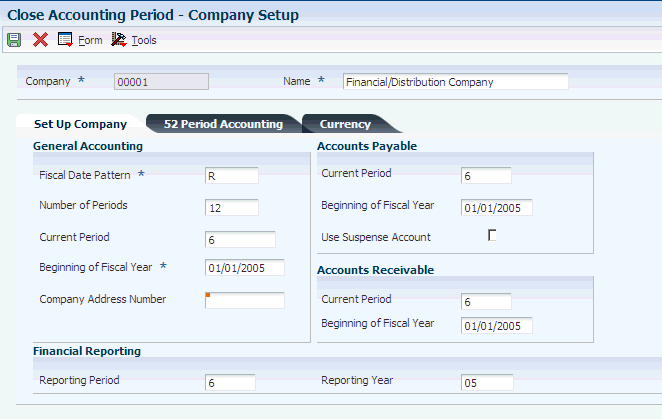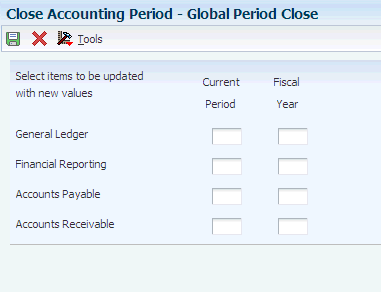42 Closing Accounting and Reporting Periods
This chapter contains the following topics:
42.1 Understanding Period-End Close Tasks
The specific process for closing an accounting period is unique to every company. Your organization should develop its own detailed closing tasks and include them in your internal documentation.
This list includes common tasks that most companies perform for an accounting period close:
-
Enter period-end accruals.
-
Review and post all batches.
-
Run integrity reports and correct errors.
Every company should include this task in their period-end closing process. Integrity reports supplement your internal balancing procedures and locate any data inconsistencies. You should run these reports before you close an accounting period as well as between closings so that you can correct problems in a timely and efficient manner. If you do not run integrity reports on a periodic basis, you risk compromising your accounting data.
-
Reconcile general ledger and bank accounts.
-
Close the accounting period for AP, AR, and GL.
-
Run financial reports.
-
Change the financial reporting period.
42.2 Closing the Accounting Period
This section provides overviews of how to close an accounting period and the effect of closing an accounting period and discusses how to:
-
Close an accounting period for a company.
-
Close the accounting period and year for a company.
-
Close an accounting period for multiple companies.
42.2.1 Understanding How to Close an Accounting Period
No special processing is required to close an accounting period. You simply increment the current period by one for AR, AP, and GL on the Company Setup form.
These rules apply to closing an accounting period:
-
You can close JD Edwards EnterpriseOne Accounts Receivable and JD Edwards EnterpriseOne Accounts Payable separately from JD Edwards EnterpriseOne General Accounting so that each system can use a different period for the current period.
The current period for the JD Edwards EnterpriseOne Accounts Receivable and JD Edwards EnterpriseOne Accounts Payable systems can be later, but not earlier, than the current period for JD Edwards EnterpriseOne General Accounting.
-
If all three systems use the same accounting period, close only JD Edwards EnterpriseOne General Accounting to increment the current period for all three systems.
-
You can reopen a GL period without reopening that period for AR and AP.
For example, you might reopen a period if you need to create entries in a prior period and the general accounting constants do not allow prior-period entries. To reopen a GL period, you change the current period on the Company Setup form.
Systems are usually closed in this order, although this order is not mandatory:
-
JD Edwards EnterpriseOne Accounts Payable
-
JD Edwards EnterpriseOne Accounts Receivable
-
JD Edwards EnterpriseOne General Accounting
After you complete your financial reporting, the last step in the close process is to change the financial reporting period to the new fiscal period.
42.2.2 Understanding the Effect of Closing an Accounting Period
When you close an accounting period, the system updates the Company Constants table (F0010) with the new accounting period and resets the date that it uses for date editing purposes. If you create entries outside the current fiscal period, you receive a warning or error. Review the possible warning and error messages:
-
PBCO (Post Before Cut Off): Entries created in a closed period.
-
PACO (Post After Cut Off) : Entries created in a future period.
-
WACO (Post Way After Cut Off): Entries created in a future year.
-
PYEB (Period Year-End Balance): Entries in a prior closed year.
A general accounting constant specifies whether entries can be posted to a closed period (PBCO).
42.2.3 Forms Used to Close the Accounting and Reporting Period
| Form Name | Form ID | Navigation | Usage |
|---|---|---|---|
| Work With Companies | W0010C | Periodic and Annual Processes (G0924), Close Accounting Period | Review company information. |
| Company Setup | W0010B | On the Work With Companies form, select the company for which you want to close the accounting period. | Close an accounting period, close the last accounting period and fiscal year, and change a financial reporting period. |
| Global Period Close | W0010D | On the Work With Companies form, select multiple companies and then select Global Close from the Row menu. | Close an accounting period, close the last accounting period and fiscal year, and change a financial reporting period for multiple companies. The companies must have the same current period and fiscal year. |
42.2.4 Closing an Accounting Period for a Company
Access the Company Setup form.
42.2.4.1 General Accounting
- Current Period
-
Increment by 1 the value in this field to close the accounting period for JD Edwards EnterpriseOne General Accounting. The system automatically closes JD Edwards EnterpriseOne Accounts Payable and JD Edwards EnterpriseOne Accounts Receivable if these systems have the same current period as JD Edwards EnterpriseOne General Accounting.
42.2.4.2 Accounts Payable
- Current Period
-
Increment by 1 the value in this field to close the accounting period for JD Edwards EnterpriseOne Accounts Payable without closing the period for JD Edwards EnterpriseOne General Accounting and JD Edwards EnterpriseOne Accounts Receivable.
If you close JD Edwards EnterpriseOne Accounts Payable and JD Edwards EnterpriseOne Accounts Receivable separately, you leave JD Edwards EnterpriseOne General Accounting open for final entries for that period.
42.2.4.3 Accounts Receivable
- Current Period
-
Increment by 1 the value in this field to close the accounting period for JD Edwards EnterpriseOne Accounts Receivable without closing the period for JD Edwards EnterpriseOne General Accounting and JD Edwards EnterpriseOne Accounts Payable.
If you close JD Edwards EnterpriseOne Accounts Receivable and JD Edwards EnterpriseOne Accounts Payable separately, you leave JD Edwards EnterpriseOne General Accounting open for final entries for that period.
42.2.5 Closing the Accounting Period and Year for a Company
Access the Company Setup form.
Before you run the Annual Close to close a fiscal year, you should close the accounting period and year on the Company Setup form. To do this, change the value in the Current Period field to 01 and enter the new fiscal year in the Beginning of Fiscal Year field for General Accounting. The system automatically applies the new period and year to Accounts Payable and Accounts Receivable after you click OK. For example, to close a calendar fiscal year for 2006, you would change the current period to 01 and the beginning date to January 1, 2007 for General Accounting.
42.2.6 Closing an Accounting Period for Multiple Companies
Access the Global Period Close form.
The functionality of this form is the same as the Company Setup form except that you can close the accounting period and, if applicable, the fiscal year for multiple companies. To do this, the companies must have the same current period and fiscal year.
- Current Period
-
Increment by 1 the value in this field for General Ledger, Accounts Payable, and Accounts Receivable.
42.3 Changing Financial Reporting Periods
This section provides an overview of financial reporting dates and discusses how to change a financial reporting periods.
42.3.1 Understanding Financial Reporting Dates
After you close the accounting period for AP, AR, and GL and run all financial reports for an accounting period, the last step in closing an accounting period is to change the financial reporting period. You change the financial reporting period to the next period on the Company Setup form to specify the new default reporting period for financial reports. The financial reporting date is used by all financial reports and is stored in the company record in the Constants table (F0010).
To generate reports for prior periods, you can reopen a financial reporting period on the Company Setup form by decreasing the reporting period. For example, if a company is currently operating in period 6, you can change the period to 5 for reporting purposes. Alternatively, you can use processing options to override the financial reporting date in the F0010 table when you run a report.
The financial reporting date for company 00000 should be the same current period and year that is used for all companies. These financial reports use the reporting period and year for company 00000, unless the first data sequence is company or business unit:
-
Simple Income Statement (R10211B)
-
Simple Balance Sheet (R10111B)
42.3.2 Changing a Financial Reporting Period
Access the Company Setup form.
42.3.2.1 Financial Reporting
- Reporting Period and Reporting Year
-
Increment by 1 the value in the Reporting Period field to specify the new default period for financial reports. To close a fiscal year, increment by 1 the value in the Reporting Year field as well.
You can specify a default financial reporting date that is different from the actual accounting period by decreasing the period by 1 or more in the Reporting Period field. This is often referred to as reopening a period and it allows you to generate financial statements for any prior period.
|
Note: Use the Global Period Close form to change the financial reporting period and, if applicable, the fiscal year for multiple companies with the same current period and fiscal year. |

